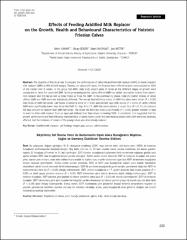Effects of feeding acidified milk replacer on the growth, health and behavioural characteristics of Holstein Friesian calves

Göster/
Erişim
info:eu-repo/semantics/openAccessTarih
2006Erişim
info:eu-repo/semantics/openAccessÜst veri
Tüm öğe kaydını gösterÖzet
Bu çalışmada, doğum ağırlığının % 8'i düzeyinde ekşitilmiş (ESİY) veya normal (tatlı) süt ikame yemi (NSİY) ile beslenen buzağıların performansları karşılaştırılmıştır. Beş hafta süre ile, % 12 kuru madde olacak şekilde hazırlanan süt ikame yemleri, toplam 21 buzağıya (10 erkek ve 11 dişi) içirilmiştir. ESİY tüketen buzağılarda büyümenin farklı evrelerinde sağlanan günlük canlı ağırlık artışları NSİY alan buzağılarla benzer şekilde olmuştur. Sütten kesim öncesi dönemde ESİY ile beslenen buzağılar süt ikame yemi, starter yem ve kuru ottan elde ettikleri kuru madde ile toplam kuru madde tüketimleri açısından NSİY ile beslenen buzağılarla benzer sonuçlar göstermiştir. Sütten kesim sonrası dönemde, ESİY ve NSİY alan buzağılarda toplam kuru madde tüketimleri istatistiksel olarak önemli derecede farklı bulunmamıştır. ESİY ile yemlenen buzağılarda genel yemden yararlanma değerinin NSİY ile beslenenlerden daha iyi (P < 0,05) olduğu belirlenmiştir. ESİY verilen buzağılarda 4-17. günler arasında dışkı kıvam puanının (P < 0,05) ve ishalli geçen günlerin oranının (P < 0,01) NSİY tüketenlere göre önemli derecede düşük olduğu bulunmuştur. ESİY ile beslenen buzağılar, NSİY alanlara göre günlük süt ikame yemlerini daha uzun (P < 0,01) bir sürede tüketmişlerdir. ESİY ile beslenen buzağılar NSİY tüketenlere göre açık kovadan herhangi bir yardım almaksızın süt ikame yemini içmeyi öğrenmek için çok daha fazla (P < 0,05) güne ihtiyaç duymuşlardır. Sonuç olarak, ESİY kullanlarak yeni geliştirilen buzağı besleme programının büyüme ve yemden yararlanma özellikleri üzerine olumsuz bir etkisinin olmadığı, ancak, genç buzağılarda ishal görülme sıklığını çok önemli miktarlarda azalttığı söylenebilir. The objective of this study was to compare the performances of calves fed acidified milk replacer (AMR) or sweet (regular) milk replacer (SMR) at 8% of birth weight. Twenty-one calves (10 males, 11 females) were offered replacers reconstituted to 12% of dry matter over 5 weeks. In the group fed AMR, daily body weight gains of calves at the different stages of growth were comparable to those for calves fed SMR. In the preweaning period, calves offered AMR had similar dry matter intakes from starter, milk replacer and dry hay as well as total intake as those fed SMR. In the postweaning phase, total dry matter intakes of calves offered AMR and SMR were not statistically different. The overall feed efficiency ratios of AMR-fed calves were better (P < 0.05) than those of SMR-fed calves. Calf faecal consistency score (P < 0.05) and percent days with scours (P < 0.01) of calves offered AMR were significantly lower than those fed SMR for days 4 to 17. AMR-fed calves needed a longer time (P < 0.01) to consume the daily amount of replacer than SMR-fed calves. The calves fed AMR also took a significantly (P < 0.05) greater number of days to learn to drink milk replacer from an open pail without help than calves consuming SMR. In conclusion, it is suggested that the growth performance and feed efficiency characteristics of calves reared under the new feeding system with AMR were not adversely affected, but the incidence of scours of the young calves was dramatically reduced.

















